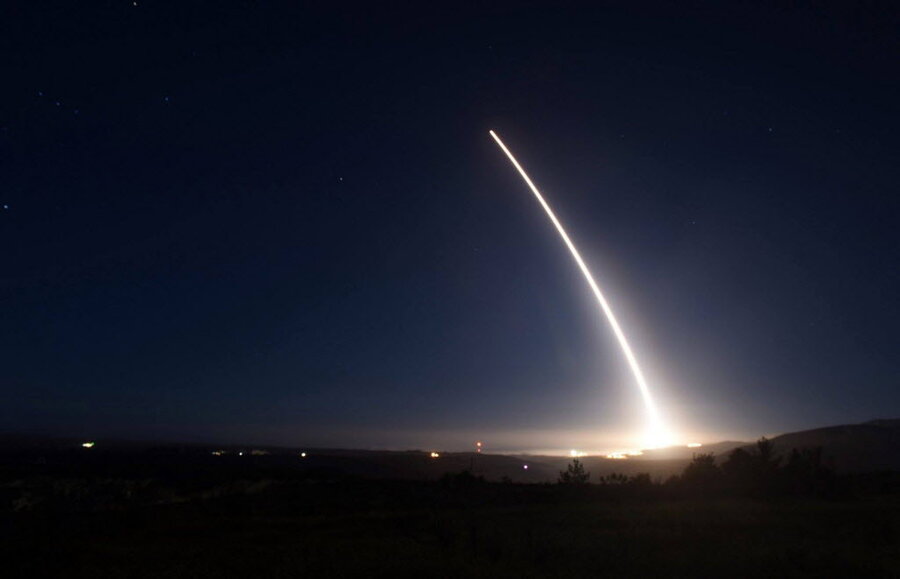How will the United States upgrade its nuclear weapons arsenal?
Loading...
Advancing the United States’s commitment to modernizing its aging nuclear fleet, the Air Force put out the call Friday for industry proposals to redesign its air-launched nuclear cruise missile and land-based intercontinental ballistic missile (ICBM) system.
The two projects fall within the government’s efforts to upgrade the country’s nuclear arsenal, at an estimated cost of $1 trillion over three decades and reignite a longstanding debate about whether the United States needs to maintain each of the three legs in the triad of its nuclear deterrence strategy, with warheads poised to launch from land, sea, and air, even with a much smaller total arsenal.
The need to update the US nuclear arsenal is broadly acknowledged, but while some experts advocate preserving the triad, others argue for focusing on the most effective weapons.
The Air Force said in a statement it will award two contracts for a new ICBM system by the end of 2017, to replace the Minuteman III missile, whose launch systems and physical infrastructure have been updated over the years but date back to the mid-1960s. Military contractors Boeing, Northrop Grumman, and Lockheed Martin will also compete to design the new air-launched missile to replace a weapon from the 1980s that has a 10 year design life.
In part, "This request for proposals is the next step to ensuring the nation's ICBM leg of the nuclear triad remains safe, secure and effective," said Major General Scott Jansson, who leads the Air Force program office for strategic systems. The request will also help build up the air-launched leg of the triad.
Some critics say that the US no longer needs ICBMs. “We have ample deterrence from the submarine force, and certainly if you add the bomber force to that, that’s an overwhelming deterrence force. So I cannot understand the argument that we also need ICBMs for deterrence. We might need ICBMs for other reasons, for geopolitical reasons, but not for deterrence. Any sane nation would be deterred by the incredible striking power of our submarine force,” Former Defense Secretary William Perry (and author of the book My Journey at the Nuclear Brink) said during an interview with the Arms Control Association.
Similarly, Nikolai Sokov, senior fellow at Center for Nonproliferation Studies in Monterey, claims that it would make sense to seriously consider moving from the nuclear triad to a two-component dyad, asking, “Does it really make sense to spend all the money on a new land-based missile, when the addition to the overall force is limited?”
US standards and planning around nuclear weapons have not been sufficiently updated since the Cold War, Dr. Sokov argues.
“The smaller the force, the more thought you need to give to the composition of the force. I would say that the Cold War standards of how you plan the force no longer apply. During the Cold War, we had thousands upon thousands of nuclear weapons. I’m just not really sure that anyone seriously considers the technical and financial impact of a much smaller force.”
The US stockpile of nuclear weapons has declined from 19,008 warheads at the collapse of the Soviet Union in 1991 to 4,571 in 2015, according to the Defense Department. Today, the strategic arsenal hovers around 1,500 deployed warheads. Russia’s President Vladimir Putin has refused President Obama’s overtures for a bilateral agreement to drop that number even further to 1,000.
Despite these calls to cut some of the weapons, other expert think that it makes sense to maintain all legs of the nuclear triad. “If we go ahead and make the investments, you basically decrease the chance of a nuclear and even a conventional war,” says Richard Weitz, Director & Senior Fellow at the Center for Political-Military Analysis of the Hudson Institute.
The idea behind updating each of the three legs, which have served the US since the 1950s, is to account for the strengths and weaknesses of each.
“They have different pluses and minuses. They complicate the ability of any opponent to basically neutralize the nuclear arsenal,” says Dr. Weitz. “Generally it’s been thought that it’s worth having all three legs and that’s my belief as well.”
The land-based nuclear missiles can be launched quickly, carry a lot of warheads, and are extremely accurate, but they can be targeted by US adversaries because they’re stored in silos whose location is known. The advantage of submarines is that they’re mobile, so no one knows where they are, but problems arise if they were to be detected or lose contact with their land-based commander. The effectiveness of the strategic bombers has declined over the years, as air defense systems have become more sophisticated.
There is a logic to retaining as many different kinds of nuclear weapons as the US can afford. “The Russians and the Chinese and even the Iranians – a lot of countries are building much better defenses against air missile attacks. You’d want to keep the bombers as far away from the anti-air defense as possible, and you’d want to make sure the missiles you launch are able to evade them as well. So basically that is the problem. The air defenses have made a lot of progress throughout the world, so it’s a lot harder for a bomber to approach and attack a target,” Dr. Weitz says.
Despite the debate among experts, the Air Force is moving ahead with its plans to modernize its land-based and air-based nuclear deterrent. “The main concern is long-term and these systems will last for decades. We wanted to have Russia as a partner at the end of the Cold War and that hasn’t happened and it’s unlikely to happen anytime soon, so we need to have the nuclear deterrent,” Dr. Weitz says.








